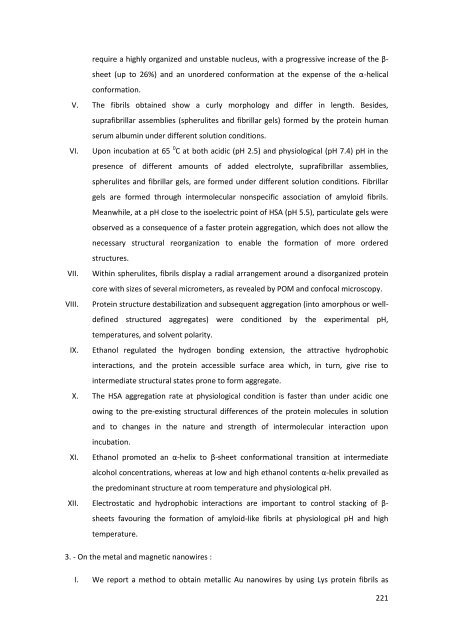Self-Assembly of Synthetic and Biological Polymeric Systems of ...
Self-Assembly of Synthetic and Biological Polymeric Systems of ...
Self-Assembly of Synthetic and Biological Polymeric Systems of ...
You also want an ePaper? Increase the reach of your titles
YUMPU automatically turns print PDFs into web optimized ePapers that Google loves.
equire a highly organized <strong>and</strong> unstable nucleus, with a progressive increase <strong>of</strong> the β-<br />
sheet (up to 26%) <strong>and</strong> an unordered conformation at the expense <strong>of</strong> the α-helical<br />
conformation.<br />
V. The fibrils obtained show a curly morphology <strong>and</strong> differ in length. Besides,<br />
suprafibrillar assemblies (spherulites <strong>and</strong> fibrillar gels) formed by the protein human<br />
serum albumin under different solution conditions.<br />
VI. Upon incubation at 65 0 C at both acidic (pH 2.5) <strong>and</strong> physiological (pH 7.4) pH in the<br />
presence <strong>of</strong> different amounts <strong>of</strong> added electrolyte, suprafibrillar assemblies,<br />
spherulites <strong>and</strong> fibrillar gels, are formed under different solution conditions. Fibrillar<br />
gels are formed through intermolecular nonspecific association <strong>of</strong> amyloid fibrils.<br />
Meanwhile, at a pH close to the isoelectric point <strong>of</strong> HSA (pH 5.5), particulate gels were<br />
observed as a consequence <strong>of</strong> a faster protein aggregation, which does not allow the<br />
necessary structural reorganization to enable the formation <strong>of</strong> more ordered<br />
structures.<br />
VII. Within spherulites, fibrils display a radial arrangement around a disorganized protein<br />
core with sizes <strong>of</strong> several micrometers, as revealed by POM <strong>and</strong> confocal microscopy.<br />
VIII. Protein structure destabilization <strong>and</strong> subsequent aggregation (into amorphous or well-<br />
defined structured aggregates) were conditioned by the experimental pH,<br />
temperatures, <strong>and</strong> solvent polarity.<br />
IX. Ethanol regulated the hydrogen bonding extension, the attractive hydrophobic<br />
interactions, <strong>and</strong> the protein accessible surface area which, in turn, give rise to<br />
intermediate structural states prone to form aggregate.<br />
X. The HSA aggregation rate at physiological condition is faster than under acidic one<br />
owing to the pre-existing structural differences <strong>of</strong> the protein molecules in solution<br />
<strong>and</strong> to changes in the nature <strong>and</strong> strength <strong>of</strong> intermolecular interaction upon<br />
incubation.<br />
XI. Ethanol promoted an α-helix to β-sheet conformational transition at intermediate<br />
alcohol concentrations, whereas at low <strong>and</strong> high ethanol contents α-helix prevailed as<br />
the predominant structure at room temperature <strong>and</strong> physiological pH.<br />
XII. Electrostatic <strong>and</strong> hydrophobic interactions are important to control stacking <strong>of</strong> β-<br />
sheets favouring the formation <strong>of</strong> amyloid-like fibrils at physiological pH <strong>and</strong> high<br />
temperature.<br />
3. - On the metal <strong>and</strong> magnetic nanowires :<br />
I. We report a method to obtain metallic Au nanowires by using Lys protein fibrils as<br />
221

















